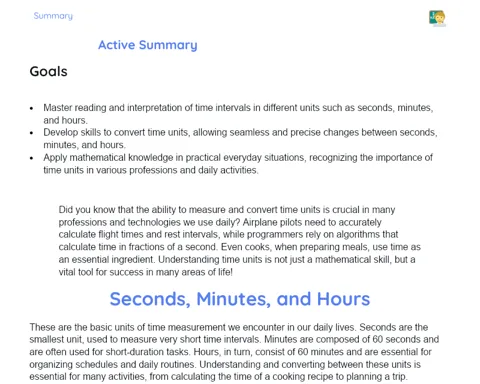Trigonometric Function: Graphs | Active Summary
Objectives
1. 🎯 Understand and describe the characteristics of the graphs of trigonometric functions, including amplitude, period, and vertical and horizontal shifts.
2. 🔍 Learn to extract important information from the graphs, such as roots, maxima, and local minima, and understand how this information is crucial in various practical applications.
Contextualization
Did you know that trigonometric functions are not only a fundamental part of mathematics but also play a crucial role in modern technologies like GPS and medical imaging? For example, satellites use trigonometric functions to determine their position relative to the Earth, and doctors use MRI images that are analyzed using trigonometric transforms to diagnose medical conditions. Understanding these functions is not just a mathematical skill, but also an essential tool for cutting-edge technological and scientific innovations!
Important Topics
Amplitude
Amplitude in a trigonometric function represents the maximum height that the function reaches above or below its central axis, which is usually the x-axis in the Cartesian plane. For sine and cosine functions, amplitude is the distance between the maximum and minimum of the function, and it is crucial for understanding the behavior of the wave. For example, in modeling sound waves, amplitude determines the intensity of the sound.
-
It is always positive for sine and cosine functions, as it represents the distance from the central axis.
-
Amplitude can be adjusted to simulate different intensities or scales of real phenomena, such as the volume of a sound or the height of a wave.
-
Understanding amplitude aids in interpreting graphs, allowing for predictions of the function's behavior in different scenarios.
Period
The period of a trigonometric function is the length of the smallest interval in which the function repeats itself. For sine and cosine functions, the period is 2π but can be modified by scaling factors and shifts. Understanding period is essential for predicting when the function will repeat, which is fundamental in cyclical phenomena like the motion of a pendulum or the seasons of the year.
-
The period affects the frequency with which the phenomenon repeats, which is crucial for practical applications involving forecasting and modeling.
-
Changes in the period can result in significant changes in the function's behavior, such as horizontal compressions or expansions.
-
Shorter periods imply higher frequencies, which can be useful in engineering and physics contexts to describe faster oscillations.
Horizontal and Vertical Shifts
Horizontal and vertical shifts in trigonometric functions refer to changes in the function's position relative to the x and y axes, respectively. These shifts are important for adjusting the function to better fit a specific dataset or to synchronize it with other functions. For example, in signal and system applications, a shift can be used to correctly align input and output signals.
-
Vertical shifts alter the 'center of mass' of the function, which can be crucial for calibrating mathematical models and adjusting experimental data.
-
Horizontal shifts can be used to correct the phase of a wave, which is vital in applications like telecommunications and electronics to ensure signal synchronization.
-
Understanding these shifts allows students to manipulate and adapt trigonometric functions to solve real-world problems with greater precision.
Key Terms
-
Amplitude: The measure of the height of a peak (or valley) of a trigonometric function relative to the horizontal axis.
-
Period: The smallest interval in which a trigonometric function completes a cycle of repetition.
-
Vertical Shift: A change in the vertical position of a graph of a trigonometric function, typically made by adding or subtracting a constant value.
-
Horizontal Shift: A change in the horizontal position of a graph of a trigonometric function, typically made by adding or subtracting a constant value.
To Reflect
-
How does the amplitude of a trigonometric function affect its interpretation in real contexts, such as in the analysis of sound waves or the modeling of natural phenomena?
-
Why is it important to understand the period of a trigonometric function, and how can this help in optimizing processes or predicting periodic behaviors?
-
In what ways can horizontal and vertical shifts be used to adjust mathematical models, and what does this tell us about the flexibility of trigonometric functions in practical applications?
Important Conclusions
-
We reviewed the essential characteristics of trigonometric functions: amplitude, period, and vertical and horizontal shifts. These properties are fundamental for describing numerous periodic phenomena in mathematics, sciences, and engineering.
-
We discussed how trigonometric functions are not just mathematical abstractions but powerful tools used in everyday technologies such as GPS and medical imaging, demonstrating their relevance and practical applicability.
-
We explored real applications ranging from modeling sound waves to predicting cyclical movements, highlighting the importance of understanding and manipulating these functions to solve complex problems in various fields.
To Exercise Knowledge
Create a presentation that explains one of the discussed concepts (amplitude, period, shifts) using an example from everyday life. Draw the graph of the function f(x) = 2sin(2x)+1 and identify its main characteristics. Use mathematics software to explore how different values of amplitude and period alter the appearance of a trigonometric function.
Challenge
Trigonometric DJ Challenge: Imagine you are a DJ who must create a mix where each song follows a sine wave pattern. Choose your favorite songs and map their rhythm and melody onto sine and cosine functions. Present your mix and the graphs of the functions in a creative video!
Study Tips
-
Practice regularly drawing and analyzing graphs of trigonometric functions, as constant practice helps solidify understanding of their properties.
-
Use digital resources like online simulators and math apps to visualize and experiment with different trigonometric functions and their parameters.
-
Try to connect what you learned about trigonometric functions with other areas of mathematics, such as calculus, to see how these concepts apply in broader and more complex ways.



